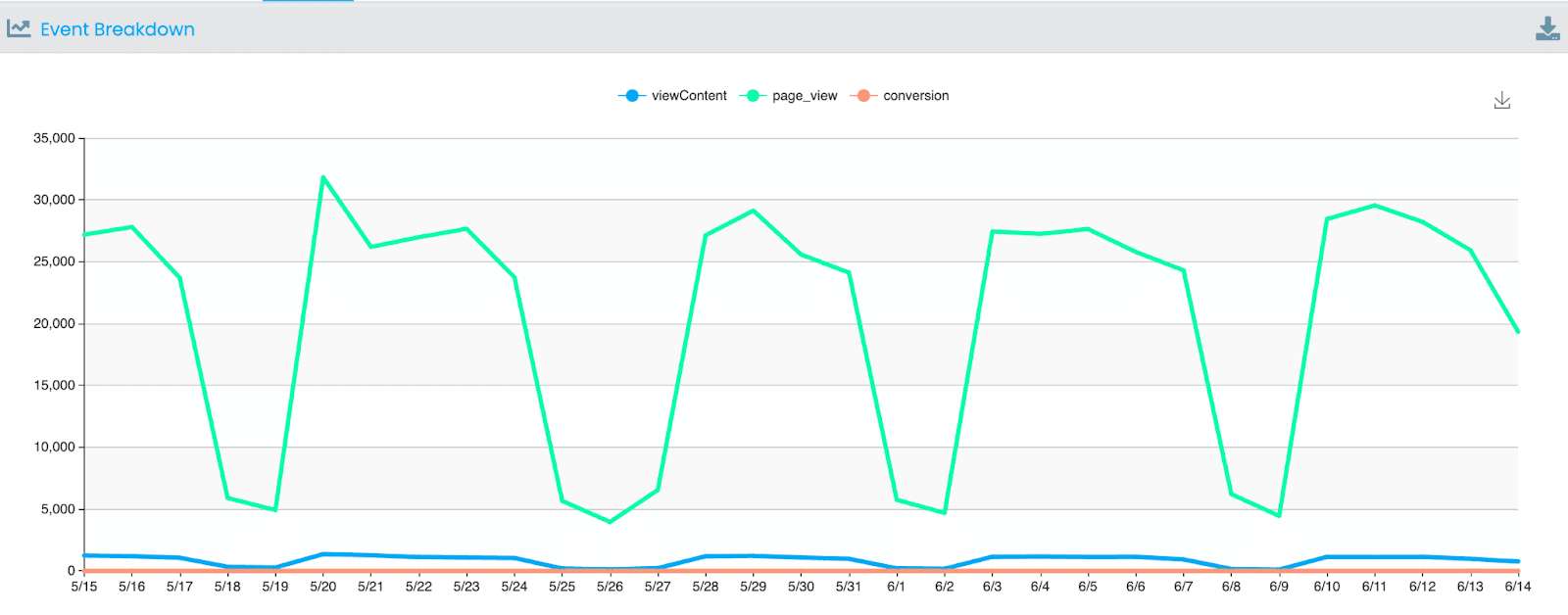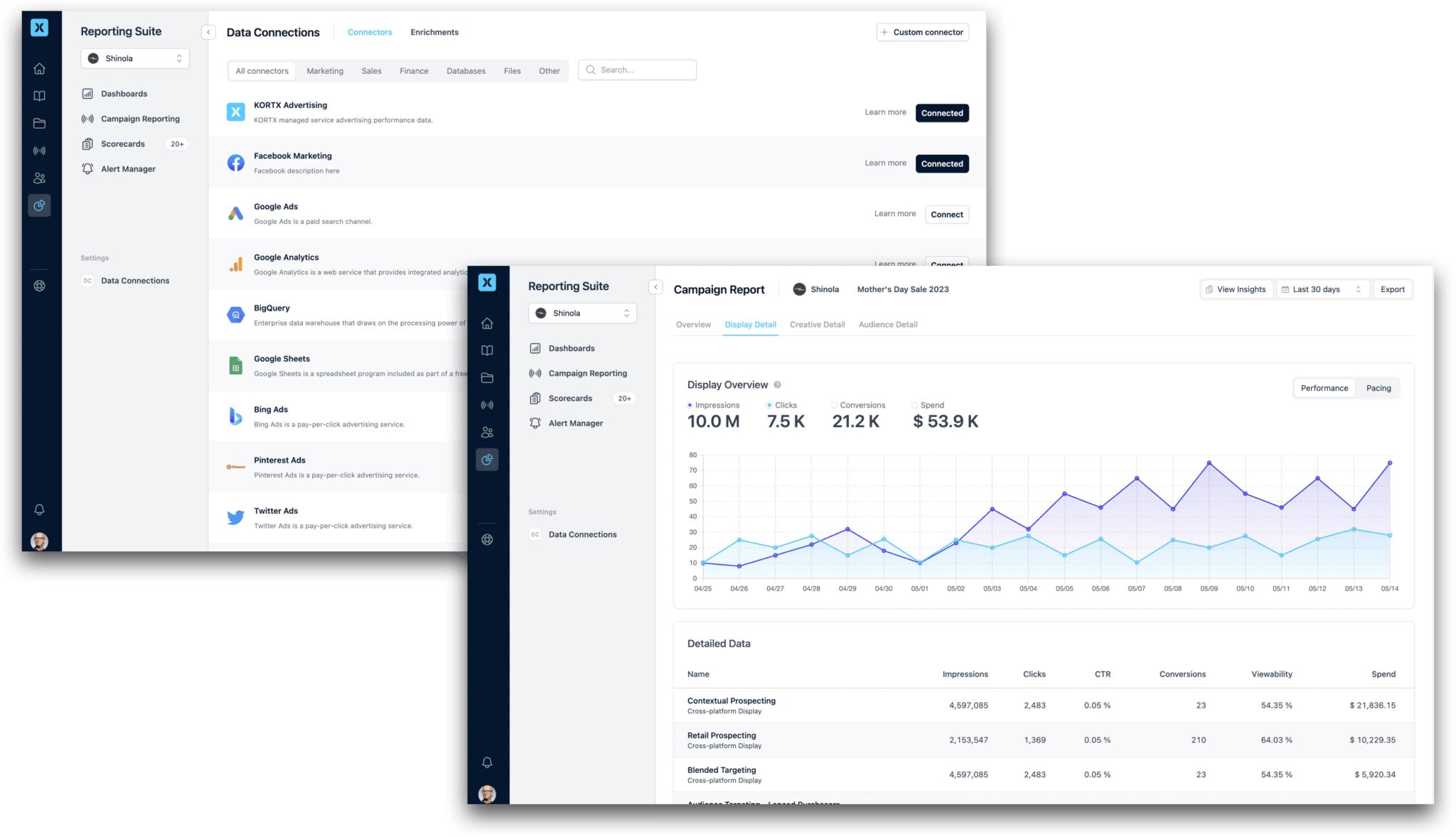Digital marketing goal setting is broken. Only 49% of marketers consistently hit their targets despite 74% setting goals. This statistic makes it clear: marketing goals must align with business objectives.
For digital marketers, hitting targets brings career stability, secures budgets, and proves your department’s value.
Explore how to set digital marketing goals that use resources wisely and achieve your desired results.
What are digital marketing goals and objectives?
Digital marketing goals and objectives are specific, measurable targets that guide a business’s online marketing efforts. They aim to increase brand awareness, drive website traffic, generate leads, or boost sales.
Why Alignment Matters Between Business Goals & Digital Marketing Goals
Aligning marketing activities with business goals supports company objectives, optimizes resources, and accurately measures performance. This leads to better resource allocation, higher efficiency, and increased revenue.
Setting and meeting aligned goals isn’t just about hitting targets—it’s about securing your job, justifying your department’s budget, and proving your value.
However, many companies independently create their strategies and departmental plans, leading to a disconnect between what the business wants and what marketing is doing. While employees often report high perceived strategic alignment (82%), actual alignment is much lower (23%).
This gap creates real problems. Organizations with larger gaps between actual and perceived alignment often face greater employee skepticism, which slows execution and results in lower-quality outcomes.
Is Your Team Really on the Same Page? The Startling Truth
Employees think they align with company goals, but their actions differ. At an ed-tech company, perceived alignment was 77%, but actual alignment was only 26%. A recruiting firm saw 90% perceived alignment, yet actual alignment was just 30%.
Alignment refers to how well employees’ actions and decisions match the company’s strategic goals and priorities. Misalignment can manifest in several ways:
- Conflicting Priorities: Teams may focus on different goals, pulling the company in conflicting directions.
- Duplicated Efforts: Misalignment can lead to redundant projects, wasting time and resources.
- Inconsistent Communication: Unaligned teams create mixed messaging, leading to customer confusion and dissatisfaction.
- Delayed Projects: Misalignment leads to delays from conflicting deadlines and poor resource management.
- Missed Opportunities: Without alignment, cross-functional collaboration suffers, causing missed chances in the market.
Example: If the marketing team prioritizes brand awareness while the sales team focuses solely on short-term revenue, their efforts might conflict, resulting in inconsistent messaging and a diluted brand presence.
Executives and employees often assume everyone is on the same page, but when goals differ, it results in unproductive meetings, communication issues, and lost value.
Without alignment, leadership may doubt marketing’s contribution to strategy and, ultimately, reconsider their investment.
CEOs are skeptical of marketing’s value.
Just 20% of CEOs trust the CMO to be “on their side,” and only 10% feel marketing prioritizes their needs.
The lack of trust doesn’t end there. Only half of CEOs feel their marketing team helps drive revenue.
How to Set Marketing Goals That Drive Business Growth
To align marketing goals with your company’s strategy, consider the following tips:
1. Involve Marketing in Setting Business Goals
Working in isolation is inefficient, slows growth, and can put your department’s budget and future at risk. Marketers need to be part of the business planning from the beginning.
Marketing’s effect on revenue isn’t always instant, especially in B2B settings. Campaigns often take time to bear fruit, depending on factors like prospect timing and sales cycles. Aligning marketing activities with revenue recognition requires understanding this timeline.
Build a healthy funnel now to secure future revenue. This will highlight marketing’s role in driving business revenue and position you to justify budget allocations and your department’s worth. Demonstrating your contribution is key to ongoing success, even in longer sales cycles.
2. Focus Your Strategy on Driving Customer Value
Aligning all levels of the organization with a customer-focused strategy is critical. Teams prioritizing customer satisfaction outperform their peers across multiple metrics, including sales, profits, and stock prices.
To make this happen, tie your business goals to a customer-centric approach, emphasizing satisfaction and engagement. Here’s how:
- Improving customer retention rates: Offer personalized loyalty programs that reward repeat purchases and long-term engagement.
- Garnering positive reviews: Encourage satisfied customers to leave reviews by sending follow-up emails with direct links to review platforms.
- Boosting interaction on digital platforms: Create engaging, interactive content like polls or quizzes that invite audience participation and shareability.
Implement feedback loops to collect and analyze customer feedback. Use this data to refine your strategies and regularly communicate improvements to customers through newsletters, social media updates, or personalized messages.
Develop digital marketing strategies based on customer needs and preferences. Use market research to create targeted campaigns that resonate with your audience, including personalized emails, engaging social media content, or informative blog posts.
When everyone in a company focuses on meeting customer needs, the company wastes less money and avoids projects that don’t help customers.
3. Translate Business Goals into SMART Marketing Objectives
Translate business goals into marketing strategies that drive revenue.
While marketing goals often align with business objectives, they have distinct focuses. Clearly differentiating goals provides a clear strategy and KPI roadmap.
Business goals are broad, overarching objectives that guide the entire organization. Examples include increasing revenue, expanding market share, enhancing brand reputation, or improving customer satisfaction.
Marketing goals are more specific and actionable steps that contribute to achieving business goals.
For example, for the business goal of increasing revenue, you will have multiple marketing objectives to help you meet your goal. These might look like:
- Increase website traffic by 30%: More website visitors create more opportunities for sales, leading to higher revenue for the company.
- Improve conversion rate by 15%: Higher conversion rates mean more visitors become customers, directly boosting sales and revenue.
- Increase on-site revenue for churned customers by 20%:Targeted upselling increases the average transaction value, contributing to overall revenue growth.
Making Them SMART
For each marketing objective, define Specific, Measurable, Achievable, Relevant, and Time-bound (SMART) goals. SMART goals provide a clear and structured framework for tracking progress and measuring success.
Example: Marketing Objective “Increasing Ad Engagement”
- Specific: Clearly define what you want to achieve. Avoid vague or general goals.
Example: Increase website traffic with programmatic display ads. - Measurable: Set quantifiable targets to track progress.
Example: Achieve a 20% increase in on-site engagement. - Achievable: Ensure your goals are realistic and attainable, given your resources.
Example: Optimize targeting by using First-Party data insights from existing customers. - Relevant: Align your goals with your overall business objectives.
Example: Increased ad traffic should result in higher conversion rates. - Time-bound: Set a clear deadline to create a sense of urgency.
Example: Achieve 20% more on-site engagement through ads within three months.
4. Set Your Digital Marketing Metrics
Once you create SMART goals, identify the specific metrics to measure your progress. Focus on actionable metrics that directly drive your business goals rather than metrics that may look impressive but offer little true business value.
📚 Related article: Successful Programmatic Advertising Measurement: Moving Beyond Vanity Metrics
Discover why vanity metrics don’t tell the full story and learn how to measure what truly matters for advertising campaigns.
Common Digital Marketing Metrics
Common metrics used in digital marketing and advertising campaigns include:
- Click-through rate (CTR): The percentage of users who click on an ad after seeing it.
- Video completion rate (VCR): The percentage of users who watch a video ad to its end.
- Cost per acquisition (CPA): The average cost of acquiring a new customer or lead.
- Conversion rates: The percentage of users who take a desired action, such as making a purchase or filling out a form.
These numbers can vary a lot depending on the industry, campaign, and who you’re targeting. For example, a Bugatti dealership might have a higher CPA because they’re selling to a more exclusive group. Meanwhile, a cosmetics retailer will have a broader audience and likely a much lower CPA.
What metrics do you recommend tracking for different types of ad campaign KPIs & objectives?
“Regarding tracking metrics for different ad campaign objectives, I recommend the following: For awareness campaigns, focus on viewability and high funnel site actions. Track low-funnel site actions for goals like purchases, form fills, and registrations. For banner engagements, monitor clicks (CTR).”
Vanity vs. Actionable Metrics
Vanity metrics are numbers that look impressive but don’t necessarily contribute to business success. They often focus on surface-level success rather than providing actionable insights. While metrics like click-through rate (CTR) and video completion rate (VCR) can be valuable, they can also be misleading if not considered in the context of overall business goals.
Instead, focus on actionable metrics that move your business and brand forward. Actionable metrics drive success. Unlike vanity metrics, they measure actual user behavior and inform data-driven decisions. These metrics quantify actions leading to desired outcomes.
Examples include:
- Customer Acquisition Cost (CAC)
- Return on Ad Spend (ROAS)
- Return on Investment (ROI)
- Customer Lifetime Value (CLTV)
In your experience, what are the most common challenges clients face when trying to align their marketing objectives with their overall business goals? How do you help them overcome these challenges?
“First and foremost, some clients have a clear idea of what they want to achieve but often lack the knowledge of how to do it. They receive a budget and ask us for a plan, but they may not fully understand our strategy. This requires a lot of communication to explain what we believe is best. Much of what we do involves educating them, especially when working directly with brands that may not have a digital marketing background, although this also happens with agencies. A major challenge is dealing with outdated KPIs like CTR, VCR, and viewability, which are still at the forefront of many clients’ marketing objectives. We focus on educating them about the benefits of optimizing for real-life site actions. At KORTX, we prioritize site actions in our campaigns, which, in my opinion, is more effective for achieving meaningful business outcomes than simply hitting vanity metrics.”
2. Building a Solid Foundation: Establishing Baselines & Benchmarks
Before starting a new marketing campaign, establish baselines and benchmarks. Analyze historical data to understand past performance trends. While past results don’t guarantee future success, they do provide valuable insights for data-driven decision-making.
Using Historical Data
Digging into historical data helps you understand audience behavior, engagement rates, and conversion metrics. But stay adaptable—shifts in audience preferences, market trends, and even seasonal changes can impact how your campaigns perform.
Keep in Mind: Benchmarks are just a starting point, not hard-and-fast rules. Every campaign is different. Target audience, messaging, and channels all play a role, so keep analyzing and adjusting based on real-time performance.
Example: B2B Weekday vs Weekend Engagement

In B2B programmatic advertising, site traffic typically declines from Friday to Sunday as potential customers are off work. Focusing efforts on the high-traffic days of Monday through Thursday can enhance engagement and improve campaign results.
Creating Benchmarks Without Historical Data
When historical digital marketing data is limited or unavailable, creating benchmarks for conversion-related metrics requires a nuanced approach. This involves making projections, focusing on goals, and researching industry trends.
Example: Setting a Cost per Conversion Benchmark
To establish a Cost per Conversion (CPC) benchmark for a new, previously unpromoted form fill action, consider this:
- Projections Based on Experience & Data: Suppose you have a 3-month banner campaign budget of $300,000. Based on your experience, you estimate this budget will generate 200,000 attributed visits to the homepage via clicks or post-impressions. Web analytics indicate that about 1% of homepage visitors in your industry fill out a form.
- Calculate Potential Benchmarks: Using these projections, you can estimate a $150 Cost per Conversion ($300,000 / (200,000 visits * 1%)), resulting in approximately 200 attributed conversions.
- Adjust & Adapt: As you proceed, be prepared to adjust your benchmarks based on real-time performance data and evolving campaign strategies.
Benchmarks for standard metrics like click-through and video completion rates are readily available. Industry reports and media partners often provide these figures, helping set realistic campaign goals.
Important Note: Benchmarks provide a helpful starting point, but they aren’t set in stone. Each brand and campaign is unique, shaped by its audience, messaging, and the channels you use. The real value comes from ongoing analysis and optimization based on actual performance data.
Staying Flexible & Data-Driven
As campaigns evolve, adjust your benchmarks based on real-time performance data. Flexibility and a data-driven approach ensure your benchmarks stay relevant and guide you toward success. Use past data to set realistic, adaptable goals and optimize for better results.
How do you establish benchmarks for new products or services that lack historical performance data?
“Without historical digital marketing data to reference, creating digital marketing benchmarks, especially regarding conversions, requires a more nuanced approach that can include making projections, focusing on goals, and researching industry trends. It is far from an exact science.”
3. The Iterative Approach: Testing, Measuring, & Refining
In digital advertising, what works today might not work tomorrow. Continuous testing is key to staying ahead and driving consistent improvements.
There are numerous elements you can test to optimize your campaigns:
- Media tactics: Experiment with display, video, paid search, and social media to find what resonates with your target audience.
- Audience targeting: Refine segments by testing demographics, interests, and behaviors to reach relevant users.
- Creative assets: A/B test images, videos, and copy to identify what drives the highest engagement and conversions.
- Campaign timing: Analyze performance at different times of day, days of the week, and seasons to optimize scheduling and maximize reach.
1. Using Data Visualization Tools
Consolidating marketing information improves efficiency, accuracy, and strategic decision-making, leading to better results.
Data visualization platforms like KORTX’s Kampus provide a holistic view of your campaign and overall marketing program, allowing you to easily identify trends, correlations, and areas for improvement.
For example, you might find a creative that excels on mobile but underperforms on desktop, prompting a strategic adjustment.

2. Test Various Tactics & Combinations
Testing can encompass various campaign elements, such as media tactics (e.g., adding Connected TV or rich media), audience segments (e.g., lookalike modeling or retargeting), and creative assets (e.g., images with QR codes vs. static). Each test can reveal valuable insights and help optimize engagement.
3. Start With A Hypothesis
Approach each test with a clear hypothesis and measurable goals. Use the SMART framework to set criteria for evaluating success. For example, “Test if adding images to emails increases click-through rates by 15% within three months.”
4. Invest Wisely
Optimize performance by allocating budget to top-performing inventory and audiences while reducing underperformers. This data-driven approach maximizes ROI and fuels continuous improvement.
Top campaigns are agile, data-driven, and iterative. Continual optimization based on real-time insights fuels their success, creating a cycle of experimentation and growth.
How Much Data Should You Have Before Examining an Ad Test Result?
When examining ad test results, confirm that your ads have reached a minimum data threshold to avoid misleading conclusions from random variations.
Here are some guidelines:
Recommended Data Thresholds for Ad Tests:
- Low Traffic: 350 impressions, 300 clicks, 7 conversions
- Mid Traffic: 750 impressions, 500 clicks, 13 conversions
- High Traffic: 1000 impressions, 1000 clicks, 20 conversions
- Well-known Brand Terms: 100,000 impressions, 10,000 clicks, 100-1000 conversions
Using these minimum data thresholds helps achieve statistical significance and reduces the impact of random events on your results. However, these are just examples or baselines, and actual thresholds may vary significantly depending on your industry and specific tactics. For most companies, a sample size of at least 1,000 impressions is generally recommended to draw reliable insights.
📚 Related article: The Data Maturity Model: Master Your Data in 5 Easy Stages
Learn how to make the most of your data in five simple steps. Improve your goal-setting and see better results.
Don’t Make These Common Benchmarketing Mistakes
Setting and using benchmarks can be challenging, even with the best intentions.
1. Setting Unrealistic Expectations
Comparing your performance to larger competitors with vastly different resources can set your team up for disappointment. Instead, focus on internal benchmarks and gradual improvement rather than chasing unattainable goals.
💡 The Solution
To avoid unrealistic expectations, communicate openly with the key stakeholders for your marketing campaigns. Discuss the factors influencing campaign performance and seek honest feedback on what is achievable within your budget, resources, and timeframe.
2. Having Limited Historical Data
Setting benchmarks and allocating budgets becomes challenging without past performance to guide projections. This can lead to misaligned expectations and complicate budget decisions.
💡 The Solution
Research industry reports from Nielsen and Gartner, case studies, and competitor analysis to find industry averages or similar campaigns. As you gather more data, refine your benchmarks to fit your unique situation. Building a mature data set takes time, so focus on incremental improvements.
What resources would you recommend for businesses learning more about setting advertising and marketing campaign objectives?
“Your Demand-Side Platform or execution arm should provide high-level suggestions on building, targeting, and optimizing your campaign based on your objectives. Additionally, many experienced media buyers and programmatic operators offer advice and pointers on Reddit, U of Digital, and The Programmatic Digest podcast. These options provide a basic understanding of programmatic execution for novices.”
3. Not Considering the Context
Benchmarks without context can be misleading. While they provide a starting point, factors like target audience, industry, and campaign objectives influence performance. Understanding these variables is crucial for setting attainable goals and optimizing campaigns.
💡 The Solution
Don’t blindly rely on industry averages or past campaign results without considering the unique nuances of your current situation. Tailor benchmarks to your specific circumstances by analyzing your unique data, market conditions, and audience behavior. Regularly update and adjust your benchmarks based on real-time insights and evolving campaign dynamics.
Remember, benchmarking is not a one-size-fits-all approach. It requires a nuanced understanding of your business, target audience, and the digital marketing industry.
Achieving Success with Digital Marketing Goals
Setting clear and actionable digital marketing goals is crucial for business growth and securing your team’s success and budget. Aligning them with your overall business objectives helps every marketing effort contribute to your company’s success.
Remember, successful digital marketing is an ongoing process of learning and adaptation. Regularly revisiting and adjusting your goals based on current data and market trends will keep your strategies effective and aligned with your business objectives.
Drive Marketing Results That Justify Your Budget
Turn data into strategies that boost conversions, ROI, and customer retention while proving your value to the company.
About the Author
Gunnar Eisenmenger is a Senior Account Manager at KORTX.



